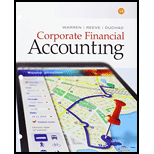
Continuing Company Analysis–Amazon:
Amazon.com, Inc. is one of the largest Internet retailers in the world. Best Buy, Inc. is a leading retailer of consumer electronics and media products in the United States. Amazon and Best Buy compete in similar markets; however, Best Buy sells through both traditional retail stores and the Internet, while Amazon sells only through the Internet. Sales and accounts receivable information for both companies for a recent period follows (in millions):
| Amazon | Best Buy | |
| Sales | $88,988 | $40,339 |
| Accounts receivable: | ||
| Beginning of year | 4,767 | 1,308 |
| End of year | 5,612 | 1,280 |
A. Determine the accounts receivable turnover for each company. (Round all calculations to one decimal place.)
B. Determine the number of days’ sales in receivables for each company. (Round all calculations to one decimal place.)
C. Evaluate the relative efficiency in collecting accounts receivables between the two companies.
D. What might explain this difference?
Trending nowThis is a popular solution!

Chapter 8 Solutions
Bundle: Corporate Financial Accounting, Loose-leaf Version, 14th + CengageNOWv2, 1 term Printed Access Card
- Financial Accounting: Shiva Corporation's break-even point in sales is $840,000, and its variable expenses are 65% of sales. If the company lost $33,000 last year, sales must have amounted to: a) $746,000 b) $860,000 c) $800,000 d) $620,000arrow_forwardPlease solve this question general accountingarrow_forwardSub: accountingarrow_forward
- A company has sales of $150 million, cost of goods sold of $100 million, and a before-tax profit of 8%. If purchasing was able to reduce the cost of goods sold by $5 million, how much additional sales would be required to achieve the same impact on profit?arrow_forwardAnswer? ? Financial accounting questionarrow_forwardThe gross margin for July?arrow_forward
- The time value of money concept is most relevant toarrow_forwardMia Vision Clinic is considering an investment that required an outlay of $505,000 and promises a net cash inflow one year from now of $660,000. Assume the cost of capital is 13 percent. Break the $550,000 future cash inflow into three components: 1. The cost of capital. 2. The profit earned on the investment.arrow_forwardGENERAL ACCOUNTINGarrow_forward
 Financial And Managerial AccountingAccountingISBN:9781337902663Author:WARREN, Carl S.Publisher:Cengage Learning,
Financial And Managerial AccountingAccountingISBN:9781337902663Author:WARREN, Carl S.Publisher:Cengage Learning, Financial Accounting: The Impact on Decision Make...AccountingISBN:9781305654174Author:Gary A. Porter, Curtis L. NortonPublisher:Cengage Learning
Financial Accounting: The Impact on Decision Make...AccountingISBN:9781305654174Author:Gary A. Porter, Curtis L. NortonPublisher:Cengage Learning Managerial AccountingAccountingISBN:9781337912020Author:Carl Warren, Ph.d. Cma William B. TaylerPublisher:South-Western College PubPrinciples of Accounting Volume 1AccountingISBN:9781947172685Author:OpenStaxPublisher:OpenStax College
Managerial AccountingAccountingISBN:9781337912020Author:Carl Warren, Ph.d. Cma William B. TaylerPublisher:South-Western College PubPrinciples of Accounting Volume 1AccountingISBN:9781947172685Author:OpenStaxPublisher:OpenStax College Survey of Accounting (Accounting I)AccountingISBN:9781305961883Author:Carl WarrenPublisher:Cengage Learning
Survey of Accounting (Accounting I)AccountingISBN:9781305961883Author:Carl WarrenPublisher:Cengage Learning





